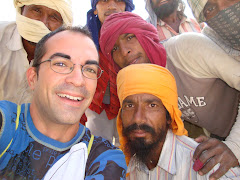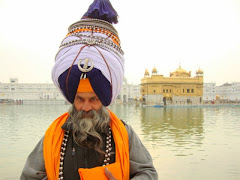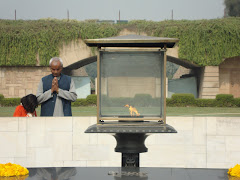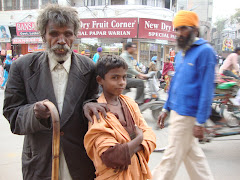 Comencem el dia de Nadal agafant un autobús fins a un poble on un conegut ens ha convidat a passar alguns dies amb la seva família. Després de viatjar durant unes quantes hores arribem al lloc en qüestió. Es tracta de quatre cases ruïnoses al bell mig del no res, amb algunes vaques, camells i micos deambulant pels carrers. Ens consolem pensant que potser l'acollida serà excel·lent i compensarà les incomoditats del viatge i la duresa de l'entorn. Però quan truquem per dir que ja hem arribat, ens trobem amb la sorpresa de que no hi ha ningú a casa i estaran fora tota la setmana. Després d'uns minuts de confusió decidim tornar a la mateixa ciutat d'on venim. Mentre esperem l'autobús, a un cantó de la carretera polsegosa, fem el nostre solitari i auster àpat de Nadal: formatge, pà de motlle i una mica d'aigua.
Comencem el dia de Nadal agafant un autobús fins a un poble on un conegut ens ha convidat a passar alguns dies amb la seva família. Després de viatjar durant unes quantes hores arribem al lloc en qüestió. Es tracta de quatre cases ruïnoses al bell mig del no res, amb algunes vaques, camells i micos deambulant pels carrers. Ens consolem pensant que potser l'acollida serà excel·lent i compensarà les incomoditats del viatge i la duresa de l'entorn. Però quan truquem per dir que ja hem arribat, ens trobem amb la sorpresa de que no hi ha ningú a casa i estaran fora tota la setmana. Després d'uns minuts de confusió decidim tornar a la mateixa ciutat d'on venim. Mentre esperem l'autobús, a un cantó de la carretera polsegosa, fem el nostre solitari i auster àpat de Nadal: formatge, pà de motlle i una mica d'aigua.A mitja tarda som de nou a la ciutat. Per tal d'arribar més ràpid a l'hotel i poder descansar decidim fer auto-stop. Un motorista s'ofereix amablement a apropar-nos al lloc on anem. Quan ens adonem, la moto està sortint de la ciutat i en direcció oposada a on havíem d'anar. Li demanem que pari i ens baixem. Com que no ens podem entendre bé, no acabem de saber cap a on ens portava ni amb quina intenció. El cas és que ara som molt més lluny de l'hotel i ens queda una bona estona de camí. Quan finalment arribem a l'hotel, gairebé entrada la nit, estem esgotats de cansament. Allà, però, ens diuen que l'amo fa una festa de Nadal i ens està esperant. Decidim afegir-nos uns minuts per veure de què es tracta. La festa no podia ser més insípida i trista. L'amo amb tres amics seus beuen whisky al voltant d'una taula. Ens conviden a afegir-nos i beure amb ells, i aquesta és tota la festa. Ja deuen portar estona de "celebració" perquè alguns d'ells arrosseguen les paraules sospitosament i quan proven de desplaçar-se ho fan sense massa equilibri. Per altra banda, un d'ells prova de petonejar-nos, entre glop i glop de whisky, mentre repeteix "Spain, I love Spain".
Mai m'han fet el pes les festes de Nadal, tan carregades de convencionalismes i de consumisme. No m'agrada que la pressió social dicti amb qui s'ha de passar tal dia, què s'ha de menjar o què s'ha de regalar. Sempre he estat més partidari de viure Nadals diferents o alternatius. Però avui, en el més profund del meu interior, crec que hauria preferit un Nadal tradicional.

 Look at the photograph. A man was going to open his car door but he found one of these sleepy Indian men resting next to one of his wheels. Look at the uncomfortable position of the body. This kind of deep-sleeping scenes are still surprising to me. It seemed to be a heart attack or a back stab but it wasn't. It was just a simple nap since the driver tryed to wake him up and the sleepy man opened his eyes slowly, got up and went to another place to continue his nap. Maybe he went to lay on the middle of the street or on a bicycle, which seem to be two of the most popular places to have a rest.
Look at the photograph. A man was going to open his car door but he found one of these sleepy Indian men resting next to one of his wheels. Look at the uncomfortable position of the body. This kind of deep-sleeping scenes are still surprising to me. It seemed to be a heart attack or a back stab but it wasn't. It was just a simple nap since the driver tryed to wake him up and the sleepy man opened his eyes slowly, got up and went to another place to continue his nap. Maybe he went to lay on the middle of the street or on a bicycle, which seem to be two of the most popular places to have a rest.


 Dues de les millors pel·lícules que he vist sobre l'Índia són "Slumdog Millionaire" y "Born into brothels", aquesta última traduïda al castellà com "Los niños del barrio rojo". La primera s'articula al voltant del concurs de televisió "¿Quiere usted ser millonario?" i tracta d'un barri de xavoles de Mumbai i la segona, sobre un barri de prostitutes de Calcuta. Em vaig quedar amb la curiositat de visitar aquestes dues realitats índies tan complexes i sòrdides. Penso que fer-se una idea d'un país significa conèixer els seus tresors però també saber com són seus inferns.
Dues de les millors pel·lícules que he vist sobre l'Índia són "Slumdog Millionaire" y "Born into brothels", aquesta última traduïda al castellà com "Los niños del barrio rojo". La primera s'articula al voltant del concurs de televisió "¿Quiere usted ser millonario?" i tracta d'un barri de xavoles de Mumbai i la segona, sobre un barri de prostitutes de Calcuta. Em vaig quedar amb la curiositat de visitar aquestes dues realitats índies tan complexes i sòrdides. Penso que fer-se una idea d'un país significa conèixer els seus tresors però també saber com són seus inferns.


 The two best movies I've ever seen about India are "Slumdog Millionaire" and "Born into brothels". The first one is about the famous TV contest "Do you want to be a millionaire?" and deals with a slum in Mumbai. The second movie is about the prostitutes and their children who live in the red-light district in Kolkatta. Since I saw the films I always kept the curiosity of visiting those complex and dark Indian realities. Moreover, I think that to know a country means to visit its treasures but also to know how its hells are.
The two best movies I've ever seen about India are "Slumdog Millionaire" and "Born into brothels". The first one is about the famous TV contest "Do you want to be a millionaire?" and deals with a slum in Mumbai. The second movie is about the prostitutes and their children who live in the red-light district in Kolkatta. Since I saw the films I always kept the curiosity of visiting those complex and dark Indian realities. Moreover, I think that to know a country means to visit its treasures but also to know how its hells are.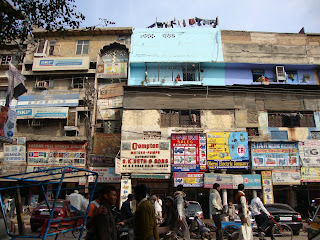







 Igual que a qualsevol ciutat del nostre país, a l'Índia un dels passatemps més populars és mirar i comentar les obres. Hi ha qui, fins i tot, treu unes cadires al carrer i gaudeix de l'espectacle des de primera línia. I és que tots, per uns minuts, hores o dies, ens podem convertir en enginyers d'obres públiques. El preu que s'ha de pagar no és massa alt: tornar a casa arrebossats amb un dit de pols.
Igual que a qualsevol ciutat del nostre país, a l'Índia un dels passatemps més populars és mirar i comentar les obres. Hi ha qui, fins i tot, treu unes cadires al carrer i gaudeix de l'espectacle des de primera línia. I és que tots, per uns minuts, hores o dies, ens podem convertir en enginyers d'obres públiques. El preu que s'ha de pagar no és massa alt: tornar a casa arrebossats amb un dit de pols.








 In India it's quite common that some people approach foreigners with curiosity and hold their hands, ask them for their name and country, and even sometimes they want to take some photographs, especially if the foreigner is a young blonde girl. Sometimes this is nice but other times so many greetings are boring and tedious. Yesterday, I had a very nice greeting. It happened while I was walking with a friend. A young guy approached us with a big smile and outstretching his arm greeted us telling us "no English!", just like a nice apology. The curiosity of Indians and the non verbal communication are stronger than any linguistic barrier.
In India it's quite common that some people approach foreigners with curiosity and hold their hands, ask them for their name and country, and even sometimes they want to take some photographs, especially if the foreigner is a young blonde girl. Sometimes this is nice but other times so many greetings are boring and tedious. Yesterday, I had a very nice greeting. It happened while I was walking with a friend. A young guy approached us with a big smile and outstretching his arm greeted us telling us "no English!", just like a nice apology. The curiosity of Indians and the non verbal communication are stronger than any linguistic barrier.


 I have the chance of taking part in the Indian rural life whenever I want since I'm living on a small farm with some horses, cows, buffalos and goats. They milk the cows twice per day. Sometimes I've tried to milk the cows but I've just been kicked away. Since then all my rural activity is reduced to playing sometimes with the calves.
I have the chance of taking part in the Indian rural life whenever I want since I'm living on a small farm with some horses, cows, buffalos and goats. They milk the cows twice per day. Sometimes I've tried to milk the cows but I've just been kicked away. Since then all my rural activity is reduced to playing sometimes with the calves.

 A l'Índia, la religió i la relació amb els déus és un afer quotidià. Gairebé tots els fidels hindús coneixen i preguen als principals déus. No a tots, ja que el panteó hindú està format per més de 330 milions de divinitats! Molts comerços tenen noms de déus. És força freqüent trobar, per exemple, "Viatges Shiva", "Hotels Vishnu" o "Transports Ganesh". Tampoc és estrany veure, de tant en tant, infants disfressats de déus. Alguns volten pels carrers, pildolant diners, i altres estan als temples, asseguts en una trona i interpretant la figura d'algun déu important. Els nens-déu dels temples acostumen a rebre diners i reverències, però els nens-déu dels carrers tot sovint reben una puntada de peu al cul.
A l'Índia, la religió i la relació amb els déus és un afer quotidià. Gairebé tots els fidels hindús coneixen i preguen als principals déus. No a tots, ja que el panteó hindú està format per més de 330 milions de divinitats! Molts comerços tenen noms de déus. És força freqüent trobar, per exemple, "Viatges Shiva", "Hotels Vishnu" o "Transports Ganesh". Tampoc és estrany veure, de tant en tant, infants disfressats de déus. Alguns volten pels carrers, pildolant diners, i altres estan als temples, asseguts en una trona i interpretant la figura d'algun déu important. Els nens-déu dels temples acostumen a rebre diners i reverències, però els nens-déu dels carrers tot sovint reben una puntada de peu al cul.
 Una de les escenes més delicioses que he contemplat darrerament ha estat la d'una petita escola al bell mig del no res. Va ser mentre caminava des de MacLeod Ganj, el poble on resideix el Dalai Lama, fins a Dharamsala, la ciutat més propera. Però no per la carretera principal sinó per un caminet de muntanya, enmig de boscos i pobles diminuts. Allà al fons, vaig albirar un grupet de nens fent classe a l'aire lliure, al costat del que devia ser una escoleta i amb un paisatge sublim de fons. Una escena per quedar-se bocabadat una bona estona.
Una de les escenes més delicioses que he contemplat darrerament ha estat la d'una petita escola al bell mig del no res. Va ser mentre caminava des de MacLeod Ganj, el poble on resideix el Dalai Lama, fins a Dharamsala, la ciutat més propera. Però no per la carretera principal sinó per un caminet de muntanya, enmig de boscos i pobles diminuts. Allà al fons, vaig albirar un grupet de nens fent classe a l'aire lliure, al costat del que devia ser una escoleta i amb un paisatge sublim de fons. Una escena per quedar-se bocabadat una bona estona.




 Today I have a new rommate. This time it's neither a frog nor a rat nor any unpleasant animal but a nice English girl who is travelling for a long time, like me. We met each other some days ago in Amritsar and, although sometimes we can't understand each other entirely, we got on enough well to decide to travel together to Dharamsala. Here, on the 10th of December, a Tibetan festival is celebrated to commemorate that the Nobel Peace Prize was conceded to Dalai Lama some years ago. Moreover Tibetans commemorate the fifty years of exile in India. So, for second time in less than a month, I've travelled to this charming village in the mountains but this time having better weather and good company.
Today I have a new rommate. This time it's neither a frog nor a rat nor any unpleasant animal but a nice English girl who is travelling for a long time, like me. We met each other some days ago in Amritsar and, although sometimes we can't understand each other entirely, we got on enough well to decide to travel together to Dharamsala. Here, on the 10th of December, a Tibetan festival is celebrated to commemorate that the Nobel Peace Prize was conceded to Dalai Lama some years ago. Moreover Tibetans commemorate the fifty years of exile in India. So, for second time in less than a month, I've travelled to this charming village in the mountains but this time having better weather and good company.



 Cada dia passo per davant d'un petit carreró estret que dóna a un espai obert. Sovint veig molta gent que entra i surt d'allà. Avui m'he decidit a entrar-hi i he descobert un tresoret, un pedaç d'història índia, tràgica i heroïca al mateix temps. Resulta que l'any 1919 els anglesos van aprovar una llei anomenada Rowlatt Act, segons la qual les autòritats podien empresonar aquells indis sospitosos d'anar contra el règim britànic. Òbviament va haver moltes protestes i manifestacions. El 13 d'abril de 1919 uns cinc mil indis es manifestàven a un lloc anomenat Jallianwala Bagh, un parc molt proper al Golden Temple, quan un general britànic va donar l'ordre a l'exèrcit d'obrir foc contra els manifestants. Unes 1500 persones van morir assassinades. Gandhi va respondre amb el seu programa de desobediència civil, sense violència però amb fermesa, anunciant que "mai no cooperaria amb aquest govern diabòlic". Sembla que l'excel·lent pel·lícula "Gandhi" relata amb fidelitat, entre altres, aquest tràgic esdeveniment històric.
Cada dia passo per davant d'un petit carreró estret que dóna a un espai obert. Sovint veig molta gent que entra i surt d'allà. Avui m'he decidit a entrar-hi i he descobert un tresoret, un pedaç d'història índia, tràgica i heroïca al mateix temps. Resulta que l'any 1919 els anglesos van aprovar una llei anomenada Rowlatt Act, segons la qual les autòritats podien empresonar aquells indis sospitosos d'anar contra el règim britànic. Òbviament va haver moltes protestes i manifestacions. El 13 d'abril de 1919 uns cinc mil indis es manifestàven a un lloc anomenat Jallianwala Bagh, un parc molt proper al Golden Temple, quan un general britànic va donar l'ordre a l'exèrcit d'obrir foc contra els manifestants. Unes 1500 persones van morir assassinades. Gandhi va respondre amb el seu programa de desobediència civil, sense violència però amb fermesa, anunciant que "mai no cooperaria amb aquest govern diabòlic". Sembla que l'excel·lent pel·lícula "Gandhi" relata amb fidelitat, entre altres, aquest tràgic esdeveniment històric. Every day I walk past a narrow street that leads to an open park. Very often I can see many people going up and down the alley. Today I decided to go in and have a look and I discovered a little treasure, a tragic and heroic piece of Indian history. The event happened in 1919 when a law was approved which gave British autorities power to imprison Indians suspected of being disloyal to British rule. On 13th of April of 1919 about 5000 Indian were doing a demonstration against that law in a place called Jallianwala Bagh when a general ordered the soldiers to open fire on the people. About 1500 people were killed. Now that place is a peaceful park in the middle of the city, very close to the Golden Temple. It's also a memorial to remember those Indians killed when they tried to defend the freedom of their country. Still you can see the holes of bullets in some old walls. Many people go there to walk, have a nap, read or just relax. It's like an oasis in the heart of Amritsar. A hidden treasure at the end of a narrow alley.
Every day I walk past a narrow street that leads to an open park. Very often I can see many people going up and down the alley. Today I decided to go in and have a look and I discovered a little treasure, a tragic and heroic piece of Indian history. The event happened in 1919 when a law was approved which gave British autorities power to imprison Indians suspected of being disloyal to British rule. On 13th of April of 1919 about 5000 Indian were doing a demonstration against that law in a place called Jallianwala Bagh when a general ordered the soldiers to open fire on the people. About 1500 people were killed. Now that place is a peaceful park in the middle of the city, very close to the Golden Temple. It's also a memorial to remember those Indians killed when they tried to defend the freedom of their country. Still you can see the holes of bullets in some old walls. Many people go there to walk, have a nap, read or just relax. It's like an oasis in the heart of Amritsar. A hidden treasure at the end of a narrow alley.
 L'hindi és la llengua que es parla a l'Índia. Però a part de l'hindi, la constitució en reconeix disset més com a oficials: bengalí, assamès, gujarati, kannara, kashmiri, konkani, malayalam, manipuri, marathi, nepalí, oriya, panjabi, sànscrit, sindhi, tamil, tagulu i urdu. Però es diu que el nombre real de llengües (no dialectes) que es parlen a l'Índia és de 1500 aproximadament. Amb això us podeu fer una idea de la magnitud que suposa l'Índia. Gairebé tots els indis són políglotes. Poden parlar l'hindi, l'anglès, la llengua del seu estat i potser la d'alguns dels estats veïns. En Narinderjit, per exemple, parla hindi, anglès, panjabí i urdu. Els indis, quan parlen, acostumen a barrejar paraules d'una i altra llengua, especialment de l'hindi i l'anglès. Per exemple, una ampolla d'aigua en diuen "pani bottle" ("pani" és aigua en hindi i "bottle" ampolla en anglès). Aquell que va dir que l'Índia és un caos que funciona, aquí pot trobar un bon exemple.
L'hindi és la llengua que es parla a l'Índia. Però a part de l'hindi, la constitució en reconeix disset més com a oficials: bengalí, assamès, gujarati, kannara, kashmiri, konkani, malayalam, manipuri, marathi, nepalí, oriya, panjabi, sànscrit, sindhi, tamil, tagulu i urdu. Però es diu que el nombre real de llengües (no dialectes) que es parlen a l'Índia és de 1500 aproximadament. Amb això us podeu fer una idea de la magnitud que suposa l'Índia. Gairebé tots els indis són políglotes. Poden parlar l'hindi, l'anglès, la llengua del seu estat i potser la d'alguns dels estats veïns. En Narinderjit, per exemple, parla hindi, anglès, panjabí i urdu. Els indis, quan parlen, acostumen a barrejar paraules d'una i altra llengua, especialment de l'hindi i l'anglès. Per exemple, una ampolla d'aigua en diuen "pani bottle" ("pani" és aigua en hindi i "bottle" ampolla en anglès). Aquell que va dir que l'Índia és un caos que funciona, aquí pot trobar un bon exemple.
 Eight years ago, a fifteen year old girl was going to be sold by her own family to a brothel in Delhi. While they were walking to the brothel she ran away and escaped from them. She hid in the first house that she found open and she asked for help from the first person she saw. That person thought the girl would be at risk of being killed if they found her and he decided to call relatives in Amritsar, to ask if they could help her. Since then, that girl who now is 23 years old, has lived in Narinderjit's house, the man who is hosting me. In return of having her at home, she does the cooking and the housework. The family love her like a daugther. They've even bought a house to give her as a dowry when she'll get married.
Eight years ago, a fifteen year old girl was going to be sold by her own family to a brothel in Delhi. While they were walking to the brothel she ran away and escaped from them. She hid in the first house that she found open and she asked for help from the first person she saw. That person thought the girl would be at risk of being killed if they found her and he decided to call relatives in Amritsar, to ask if they could help her. Since then, that girl who now is 23 years old, has lived in Narinderjit's house, the man who is hosting me. In return of having her at home, she does the cooking and the housework. The family love her like a daugther. They've even bought a house to give her as a dowry when she'll get married. Avui passa un fet insòlit a la ciutat: tots els comerços estan tancats. I no perquè sigui diumenge ni festiu, no. Aquí la majoria de botigues obren cada dia, fins i tot diumenges. Però avui és dia de vaga. Fa un parell de dies, a Ludhiana, que és una ciutat propera a Amritsar, va morir una persona quan la policia intentava controlar una manifestació a cops de bastó. En senyal de protesta tot l'estat del Punjab avui fa vaga general. Només els venedors ambulants i els rickshaws treballen. Ells no tenen portes que tancar.
Avui passa un fet insòlit a la ciutat: tots els comerços estan tancats. I no perquè sigui diumenge ni festiu, no. Aquí la majoria de botigues obren cada dia, fins i tot diumenges. Però avui és dia de vaga. Fa un parell de dies, a Ludhiana, que és una ciutat propera a Amritsar, va morir una persona quan la policia intentava controlar una manifestació a cops de bastó. En senyal de protesta tot l'estat del Punjab avui fa vaga general. Només els venedors ambulants i els rickshaws treballen. Ells no tenen portes que tancar.
 Fa vuit anys, una nena de quinze anys anava a ser venuda per la seva pròpia família a un bordell de Delhi. De camí cap al bordell, però, la noia va arrencar a córrer i va fugir. Es va amagar, morta de por, a una casa que va trobar amb la porta oberta. Va explicar la seva situació a la primera persona que va veure i va demanar ajuda. Aquesta persona va pensar que la vida de la noia corria perill en cas de que la descobrissin i va decidir trucar a uns familiars d'Amritsar per mirar si la podien ajudar. Aquesta noia, que ara té 23 anys, viu des de llavors a casa d'en Narinderjit, l'home que m'acull (el de la fotografia). A canvi de tenir-la a casa, ella cuina i els fa les feines de la llar. Ells l'estimen com si fos una filla més. Fins i tot, li han comprat una casa a un poble proper que li donaran com a dot quan es casi. I és que, tal com diu Álvaro Enterría, "en la India se pueden contemplar las escenas más sublimes i las más espeluznantes". Vet aquí un bon exemple.
Fa vuit anys, una nena de quinze anys anava a ser venuda per la seva pròpia família a un bordell de Delhi. De camí cap al bordell, però, la noia va arrencar a córrer i va fugir. Es va amagar, morta de por, a una casa que va trobar amb la porta oberta. Va explicar la seva situació a la primera persona que va veure i va demanar ajuda. Aquesta persona va pensar que la vida de la noia corria perill en cas de que la descobrissin i va decidir trucar a uns familiars d'Amritsar per mirar si la podien ajudar. Aquesta noia, que ara té 23 anys, viu des de llavors a casa d'en Narinderjit, l'home que m'acull (el de la fotografia). A canvi de tenir-la a casa, ella cuina i els fa les feines de la llar. Ells l'estimen com si fos una filla més. Fins i tot, li han comprat una casa a un poble proper que li donaran com a dot quan es casi. I és que, tal com diu Álvaro Enterría, "en la India se pueden contemplar las escenas más sublimes i las más espeluznantes". Vet aquí un bon exemple.


